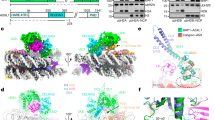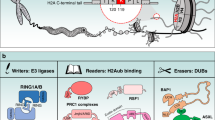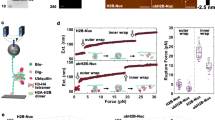Abstract
A key step in gene repression by Polycomb is trimethylation of histone H3 K27 by PCR2 to form H3K27me3. H3K27me3 provides a binding surface for PRC1. We show that monoubiquitination of histone H2A by PRC1-type complexes to form H2Aub creates a binding site for Jarid2–Aebp2–containing PRC2 and promotes H3K27 trimethylation on H2Aub nucleosomes. Jarid2, Aebp2 and H2Aub thus constitute components of a positive feedback loop establishing H3K27me3 chromatin domains.
This is a preview of subscription content, access via your institution
Access options
Subscribe to this journal
Receive 12 print issues and online access
$189.00 per year
only $15.75 per issue
Buy this article
- Purchase on Springer Link
- Instant access to full article PDF
Prices may be subject to local taxes which are calculated during checkout


Similar content being viewed by others
References
Margueron, R. & Reinberg, D. Nature 469, 343–349 (2011).
Simon, J.A. & Kingston, R.E. Mol. Cell 49, 808–824 (2013).
Pengelly, A.R. et al. Science 339, 698–699 (2013).
Whitcomb, S.J. et al. J. Biol. Chem. 287, 23718–23725 (2012).
Yuan, G. et al. J. Biol. Chem. 288, 30832–30842 (2013).
Cao, R. & Zhang, Y. Mol. Cell 15, 57–67 (2004).
Li, G. et al. Genes Dev. 24, 368–380 (2010).
Zhang, Z. et al. Stem Cells 29, 229–240 (2011).
Son, J. et al. Genes Dev. 27, 2663–2677 (2013).
Wang, H. et al. Nature 431, 873–878 (2004).
Lagarou, A. et al. Genes Dev. 22, 2799–2810 (2008).
Gearhart, M.D. et al. Mol. Cell. Biol. 26, 6880–6889 (2006).
Gao, Z. et al. Mol. Cell 45, 344–356 (2012).
Endoh, M. et al. PLoS Genet. 8, e1002774 (2012).
Gutiérrez, L. et al. Development 139, 117–127 (2012).
Ong, S.E. et al. Mol. Cell. Proteomics 1, 376–386 (2002).
Schmitges, F.W. et al. Mol. Cell 42, 330–341 (2011).
Buchwald, G. et al. EMBO J. 25, 2465–2474 (2006).
Klymenko, T. et al. Genes Dev. 20, 1110–1122 (2006).
Spruijt, C.G. et al. Cell 152, 1146–1159 (2013).
Vermeulen, M. Methods Enzymol. 512, 137 (2012).
Smits, A.H., Jansen, P.W., Poser, I., Hyman, A.A. & Vermeulen, M. Nucleic Acids Res. 41, e28 (2013).
Ciferri, C. et al., eLife 1, e00005 (2012).
Acknowledgements
This project was supported by the European Commission Seventh Framework Program 4DCellFate, grant number 277899 to C.W.M., M.V. and J.M. R.K. and J.M. acknowledge support by the Microchemistry core facility at the Max Planck Institute of Biochemistry and financial support from the Max Planck Society. S.L. and C.W.M. acknowledge support by the Proteomics Core Facility at the European Molecular Biology Laboratory (EMBL). C.W.M. acknowledges support by EMBL. M.V. acknowledges support from the Netherlands Organization for Scientific Research (NWO-VIDI and Cancer Genomics Netherlands). M.V. thanks C.G. Spruijt and A.H. Smits in his laboratory for providing SILAC-labeled mouse embryonic stem cell extracts and for help with data analysis, respectively.
Author information
Authors and Affiliations
Contributions
R.K. generated the unmodified and H2Aub nucleosome substrates, prepared Drosophila nuclear extracts and performed the pulldown experiments and the HMTase assays. H.I.B. and P.W.T.C.J. performed the MS analyses. S.L. prepared PRC2 and AEBP2-containing PRC2, and R.K. prepared JARID2. J.M., M.V. and C.W.M. supervised the project. J.M. and R.K. wrote the paper.
Corresponding author
Ethics declarations
Competing interests
The authors declare no competing financial interests.
Integrated supplementary information
Supplementary Figure 1 Recombinant proteins used for in vitro ubiquitination and methylation of nucleosomes.
(a) Coomassie-stained 4-12% polyacrylamide gel showing purified recombinant human ubiquitin activating enzyme UBE1 (lane1), human ubiquitin-conjugating enzyme UBCH5C (lane 2), mouse ubiquitin ligase Ring1b1–130/Bmi11–109 (lane 3) and Ubiquitin (lane 4).
(b) Reconstituted recombinant Drosophila or Xenopus oligonucleosomes were subjected to ubiquitination (+ Ring1b1–130/Bmi11–109, lane 2 in both cases) or mock (− Ring1b1–130/Bmi11–109, lane 1 in both cases) reactions and products were visualized by Coomassie staining after separation on denaturing 16% Tris-Glycine polyacrylamide gels (top) Note the size shift of the unmodified H2A band in lanes 1 and 3 to the monoubiquitinated H2A band in lanes 2 and 4, respectively; in both cases, a very small fraction appears to become di-ubiquitinated (H2Aub2). The band marked by an asterisk is a contaminant that sometimes is observed in UBE1 preparations.
Bottom: Western blot analysis of the same reactions shown above with antibody against unmodified histone H2A. Reaction products were separated on 4-12% BT MES polyacrylamide gels. Note the size shift of the unmodified H2A band in lanes 1 and 3 to the monoubiquitinated H2A band in lanes 2 and 4, respectively.
Supplementary Figure 2 Recombinant proteins and nucleosomes used for HMTase assays on mono- and oligonucleosomes.
(a) Coomassie stained polyacrylamide gels with purified recombinant PRC2 (left), AEBP2-PRC2 (middle) and JARID2 (right). Recombinant purified PRC2 consisting of EZH2, SUZ12, EED, RBBP4 (left). AEBP2-PRC2 additional contains AEBP2 (middle). These PRC2 complexes and JARID2 were used for the experiments shown in Fig. 2 and Figure S2.
(b) Non-ubiquitinated and ubiquitinated mononucleosomes after coupling to streptavidin coated Dynabeads (M-280).
(c) and (d) JARID2 and H2Aub stimulate H3-K27 methyltransferase activity of AEBP2-PRC2. (c) Western blot analysis of H3-K27me1 and -me3 formation in HMTase reactions performed with AEBP2-PRC2 (134 nM, lanes 3-6) in the absence (lanes 3, 4) or presence of JARID2 (120 nM, lanes 5,6) on recombinant Xenopus mononucleosomes (460 nM) that were unmodified (lanes 1, 3, 5) or contained H2Aub (lanes 2, 4, 6) (see Figure S1); histone H4 signal served as loading control. Histogram shows quantification of H3-K27me3 chemiluminescence signal by ImageJ; no signal is detected in lanes 1, 2 (asterisk). Note the increase of H3-K27me3 tri-methylation when H2A is monoubiquitinated and JARID2 is added to the reaction. The reduction of H3-K27me1 signal in lane 6 suggests that most H3-K27 residues became di- or tri-methylated. (d) as in (c) but with recombinant Xenopus 4-mer oligonucleosomes (460 nM) as substrate. The reaction contained 67 nM AEBP2-PRC2 and 60 nM JARID2. Supplementary Figure S5 shows original blots.
Supplementary Figure 3 Original Coomassie gels for pulldown reactions.
Left: Full gel image of the triplicate pull-down reactions from Drosophila nuclear extracts. Area of the gel boxed in blue is shown in Figure 1a.
Right: Full gel image of the SILAC pull-down experiment from mouse embryonic stem cell nuclear extracts. Area of the gel boxed in blue is shown in Figure 1b.
Supplementary Figure 4 Full-size scans of western blot membranes shown in Figure 2.
Scans are arranged in the same order as shown in Figure 2a,b and cropped portions are boxed in blue.
Supplementary Figure 5 Full-size scans of western blot membranes shown in Supplementary Figure 2.
Scans are arranged in the same order as shown in Figure S2c,d and cropped portions are boxed in blue.
Supplementary information
Supplementary Text and Figures
Supplementary Figures 1–5 (PDF 7993 kb)
Supplementary Table 1
Identification and quantification of proteins detected in two SILAC-based H2A vs H2Aub nucleosome pulldowns. (XLSX 142 kb)
Rights and permissions
About this article
Cite this article
Kalb, R., Latwiel, S., Baymaz, H. et al. Histone H2A monoubiquitination promotes histone H3 methylation in Polycomb repression. Nat Struct Mol Biol 21, 569–571 (2014). https://doi.org/10.1038/nsmb.2833
Received:
Accepted:
Published:
Issue Date:
DOI: https://doi.org/10.1038/nsmb.2833
This article is cited by
-
Epigenetics: Toward improving crop disease resistance and agronomic characteristics
Plant Biotechnology Reports (2024)
-
Functional dissection of PRC1 subunits RYBP and YAF2 during neural differentiation of embryonic stem cells
Nature Communications (2023)
-
Changes in PRC1 activity during interphase modulate lineage transition in pluripotent cells
Nature Communications (2023)
-
KDM2B regulates hippocampal morphogenesis by transcriptionally silencing Wnt signaling in neural progenitors
Nature Communications (2023)
-
Evolutionary adaptation of the Polycomb repressive complex 2
Epigenetics & Chromatin (2022)



